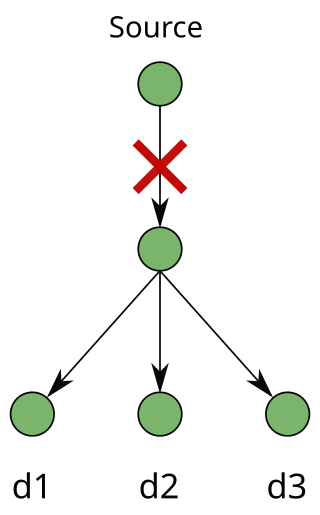Link Protection in the Optical Transport Layer
In older high-speed transport networks, the SONET layer (also SDH) was the main client wavelength-division multiplexing (WDM) layer. For this reason, before WDM protection schemes were defined, SONET protection mechanisms were mainly adopted to guarantee optical network survivability. When the WDM layer was created, the optical networks survivability techniques in consideration were mainly based on many elements of SONET protection in order to ensure maximum compatibility with the legacy systems (SONET systems). Hence some of the WDM-layer protection techniques are very similar to SONET/SDH protection techniques in the case of ring networks. [1]
Ring-Based protection

In the case of a link or network failure, the simplest mechanism for network survivability is automatic protection switching (APS). APS techniques involve reserving a protection channel (dedicated or shared) with the same capacity of the channel or element being protected. [2] When a shared protection technique is used, an APS protocol is needed to coordinate access to the shared protection bandwidth. [3] An example of a link-based protection architecture at the Optical Transport Network layer is a Bidirectional Line Switched Ring (BLSR). In a BLSR, every link can carry both the working and backup traffic at the same time and hence does not require backup links. Unlike a UPSR (see SONET), in a BLSR, under normal circumstances, the protection fiber is unused and this is beneficial to ISP's since they can use the protection fiber to send lower priority traffic (using protection bandwidth) like data traffic and voice traffic.
There are two architectures for BLSRs. The four-fiber BLSR and the two-fiber BLSR. In a four-fiber BLSR, two fibers are used as working fibers and the other two are used as protection fibers, to be utilized in the case of a failure. Four-fiber BLSRs use two types of protection mechanisms during failure recovery, namely ring and span switching. In span switching, when the source or destination on a link fails, traffic gets routed onto the protection fiber between the two nodes on the same link and when a fiber or cable cut occurs, service is restored using the ring switching mechanism.
In a two-fiber BLSR, the protection fibers are contained within the working fibers (like a four-fiber BLSR) and both the fibers are used to carry working traffic whilst keeping only half the capacity on each fiber for protection purposes. Two-fiber BLSRs also benefit from the ring switching but cannot perform span switching like a four-fiber BLSR.
Due to its efficiency in protection, BLSRs are widely deployed in long haul and interoffice networks, where the traffic pattern is more distributed than in access networks. Most metro carriers have deployed two-fiber BLSRs, while many long-haul carriers have deployed four-fiber BLSRs since they can handle more load than two-fiber BLSRs. [1]
Mesh-based protection
The techniques mentioned above for SONET and WDM networks can also be applied to mesh network architectures provided there are ring decompositions for the mesh architectures; and use well defined protection-switching schemes to restore service when a failure occurs. The three most notable ring-based protection techniques for mesh networks are ring covers, cycle double covers and p-cycles (pre-configured protection cycles).
The main goal of the ring cover technique is to find a set of rings that covers all the network links and then use these rings to protect the network against failures. Some network links in the ring cover might get used in more than one ring which can cause additional redundancy in the network and because of this reason, scaling down redundancy is the primary focus of this technique.
The cycle double covers technique provides one protection fiber for each working fiber (like in SONET rings) keeping 100% redundancy. This technique was initially proposed to remove the additional redundancy issue caused by the ring cover scheme. [4]
The p-cycle technique is based on the property of a ring to protect not only its own links, but also any possible links connecting two non-adjacent ring nodes called chordal links. By doing this, p-cycles reduce the redundancy required to protect a mesh network against link failure. There are two types of p-cycles namely link p-cycles and node p-cycles. Link p-cycles protect all channels on a link whereas a node p-cycle protects all the connections traversing a node.
One of the best features of p-cycles is its ability to allow savings in spare resources and they are also recognized to be the most efficient protection structures as for capacity minimization. However, p- cycle planning is an NP-hard problem and is not scalable. [1]
Another technique called the generalized loopback technique can be included under ring-based approaches. Although it is not strictly considered as one of the mesh-based ring protection techniques, its usage of a loopback operation is similar to the APS operation in rings to switch the signal from working to the redundant capacity. [4]







